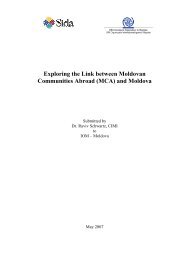specific needs of children and elderly left behind as a ... - IOM Moldova
specific needs of children and elderly left behind as a ... - IOM Moldova
specific needs of children and elderly left behind as a ... - IOM Moldova
You also want an ePaper? Increase the reach of your titles
YUMPU automatically turns print PDFs into web optimized ePapers that Google loves.
Policies <strong>and</strong> mechanisms existing on the protection <strong>of</strong> <strong>children</strong> <strong>and</strong> the <strong>elderly</strong><br />
Central public authorities involved in providing social services for the <strong>elderly</strong><br />
are the Ministry <strong>of</strong> Labour, Social Protection <strong>and</strong> Family <strong>and</strong> the<br />
Ministry <strong>of</strong> Health. At this level social services with high specialization<br />
are administered.<br />
The social services with high specialization are the most requested ones due<br />
to limited access to other social services. Residential care services (24/24<br />
hours) are oriented towards the <strong>elderly</strong> that face extremely serious problems.<br />
Residential care services dem<strong>and</strong> high costs not reflecting <strong>and</strong> satisfying<br />
entirely beneficiaries’ <strong>needs</strong>. They could benefit from social services in<br />
families or in their communities. There are 4 residential psycho-neurological<br />
institutions with high specialization subordinated to the Ministry <strong>of</strong> Labour,<br />
Social Protection <strong>and</strong> Family <strong>and</strong> the health resorts from Vadul lui Voda <strong>and</strong><br />
Segheevka, Ukraine also provides services to the <strong>elderly</strong>.<br />
It is important to note that these types <strong>of</strong> services can be managed by central<br />
authorities or by local public administration authorities <strong>of</strong> the 2nd level (district).<br />
“The institutionalization process <strong>of</strong> the <strong>elderly</strong> takes place after <strong>as</strong>sessing<br />
their <strong>needs</strong>. Still, the goal <strong>of</strong> the reform <strong>of</strong> the social <strong>as</strong>sistance system is to<br />
avoid institutionalization, finding all solutions to render support to the <strong>elderly</strong><br />
at their homes <strong>as</strong> well <strong>as</strong> in their community. If all resources were already<br />
used, the <strong>elderly</strong> h<strong>as</strong> to p<strong>as</strong>s the stages described by the mechanisms <strong>of</strong> referring<br />
beneficiaries within the social <strong>as</strong>sistance system” (III_EE_7). Over the<br />
l<strong>as</strong>t years an incre<strong>as</strong>ed dem<strong>and</strong> for this type <strong>of</strong> services w<strong>as</strong> observed <strong>as</strong><br />
well <strong>as</strong> obstacles in accessing these: “it is very difficult to place an old person<br />
in a placement centre, only with the help <strong>of</strong> MLSPS from Chisinau. To get their<br />
permission you have to advance well-founded arguments <strong>and</strong> it is a great success<br />
if a person aged 100 is placed there” (FG_EE_urban).<br />
The essential feature <strong>of</strong> residential care services for the <strong>elderly</strong> lie in the<br />
fact that these services do not treat beneficiaries individually; in many<br />
c<strong>as</strong>es the institution’s employees do not have experience <strong>and</strong> knowledge in<br />
working with the <strong>elderly</strong>; there is no system to re-<strong>as</strong>sess the situation <strong>of</strong> the<br />
<strong>elderly</strong> for a potential integration in the family or community. Thus, these<br />
peculiarities <strong>of</strong> the residential system bring to a halt all connections <strong>of</strong> the<br />
family with the institutionalized <strong>elderly</strong>, leading to their social isolation<br />
<strong>and</strong> a chronic dependence upon the residential system.<br />
It is worth mentioning legal actions taken to improve local public authorities’<br />
capacity for developing particular services. In this regard a relevant<br />
issue is the potential to develop services at the local level: “authorities do<br />
not posses enough knowledge to work out functioning regulations <strong>of</strong> <strong>specific</strong><br />
services or institutions. They <strong>as</strong>k for the ministry’s support in finding a solution”<br />
(III_EE_8).<br />
Medical care services for the <strong>elderly</strong> <strong>left</strong> <strong>behind</strong> are supported by the social<br />
insurance fund <strong>and</strong> are included in the set <strong>of</strong> services covered by com-<br />
215

















